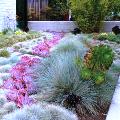
Water-efficient Landscaping
In many areas of the country, water use for irrigation exceeds indoor consumption, averaging more than 50% of total residential consumption in the U.S. So, while installing water-efficient fixtures inside a home is an important step toward water efficiency, addressing outside use should be at the top of your list, especially if your projects are in drought-prone locations.
But where outfitting a home with efficient bath fixtures is pretty straightforward, designing and installing water-efficient landscaping and irrigation can be complex. Designing a landscape to conserve water—xeriscaping—requires choosing plants that will thrive in your region and your project’s particular microclimate; limiting the turf areas; making sure the soil on site will promote water absorption and deep root growth; and, if irrigation is installed, using an efficient system.
Initial Steps
First, do no harm. Preserving soil quality is important for water efficiency. Also, commit to losing some lawn. Some local and regional governments offer financial incentives to reduce the size of irrigated lawns. The EPA’s Water Sense program for single-family homes recommends limiting turf area to a maximum of 40% of the site, balancing the rest of the landscaping with drought-resistant plantings and permeable surfaces. Water Sense also recommends treating slopes in excess of 4:1 with vegetation that will help keep stormwater from running off the site, and covering exposed soil areas in planting beds with a 2- to 3-inch layer of mulch.
Water Wisely:
Irrigation systems should include separate zones to accommodate different watering requirements, drip irrigation for plant beds, and rotating sprinkler heads for turf areas that should be laid out to avoid duplicate coverage and watering paved areas and buildings. Surface runoff can be reduced by keeping the precipitation rate from sprinklers below the soil’s infiltration rate, and establishing different zones for the tops and toes of slopes.
Overwatering is a major problem, The Irrigation Association’s (IA) Smart Water Application Technologies (SWAT) program, a partnership between water utilities and industry representatives, promotes the use of “smart” irrigation control technology that uses climate, site, horticultural, and/or soil moisture information to adjust irrigation to conditions on the site.
Case studies carried out by the IA suggest that systems that use smart controllers can reduce water use by 20% to 40% compared to timer-based systems.
Let it Rain:
Harvesting, or simply redirecting water from downspouts to plants (along with utilizing porous materials for non-planted areas) keeps runoff out of the sewer system, easing stress on infrastructure while allowing more water to percolate back into the groundwater. Water from a small roof area can simply be sent to a lawn or planting bed; larger amounts can supply a specially designed rain garden that is graded to collect water, filled with well-drained soil, and planted with species that can tolerate inundation as well as drier periods in between storms. Some local governments offer design assistance or even grants to expand the use of rain gardens and other techniques that treat rainwater as a resource, not a waste product.
Full Post

A (very brief) Guide to Istanbul
Istanbul is located on both the continents of Europe and Asia. Most citizens practice Islam, but the city also claims strong Christian and Jewish communities. Istanbul is thus known as a cultural melting pot, and the city’s architecture certainly lives up to that reputation.
Visitors to Istanbul will find more than 2,000 mosques, 100 churches and 20 synagogues. Over time, Istanbul has served as a capital for Roman, Byzantine, Latin and Ottoman Empires, and is now Turkey’s capital. Each period built a new architectural layer on top of the old, and many of these monuments remain intact.
Predominant Architecture::
The Ancient Romans and Greeks left their aqueducts and the Walls of Constantine. The Byzantines and Genoese left their domed churched with arches. The Ottoman Empire left its castles, palaces and mosques. And the European Baroque styles and Art Nouveau palaces and mansions that followed add more to the eclectic landscape of Istanbul.
Places to See:
Hagia Sophia: This museum was once a church and then a mosque. Hagia Sophia, also known as the Church of the Holy Wisdom, is most known for its unique dome.
Blue Mosque: Six minarets towering over the skyline of Istanbul make it easy to locate the Blue Mosque. On closer inspection, visitors can also observe a series of cascading domes on the building’s exterior.
Column of Constantine: When Constantine the Great declared the city the capital of the Roman Empire in 330, he built this commemorative column.
Hippodrome: The arena with the scenes of chariot races and also cultural focus of the Byzantine (Roman) Empire. Remains of the three of the great monuments can be seen: the Obelisk of Theodosius, the bronze Serpentine Column and the Column of Constantine.
Underground Cistern: Built in the fourth century, is one of the underground cisterns that riddle the foundations of the city. It has been extensively excavated and renovated and is worth visiting and exploring while listening to the tunes of classical music.
Grand Bazaar: The world’s biggest covered historic Bazaar. It is one of the most famous spots of Istanbul, always filled with crowds who not only come to shop but to window-shop carpets, jewellery, leathers,handcrafts, home decoration items and many more.